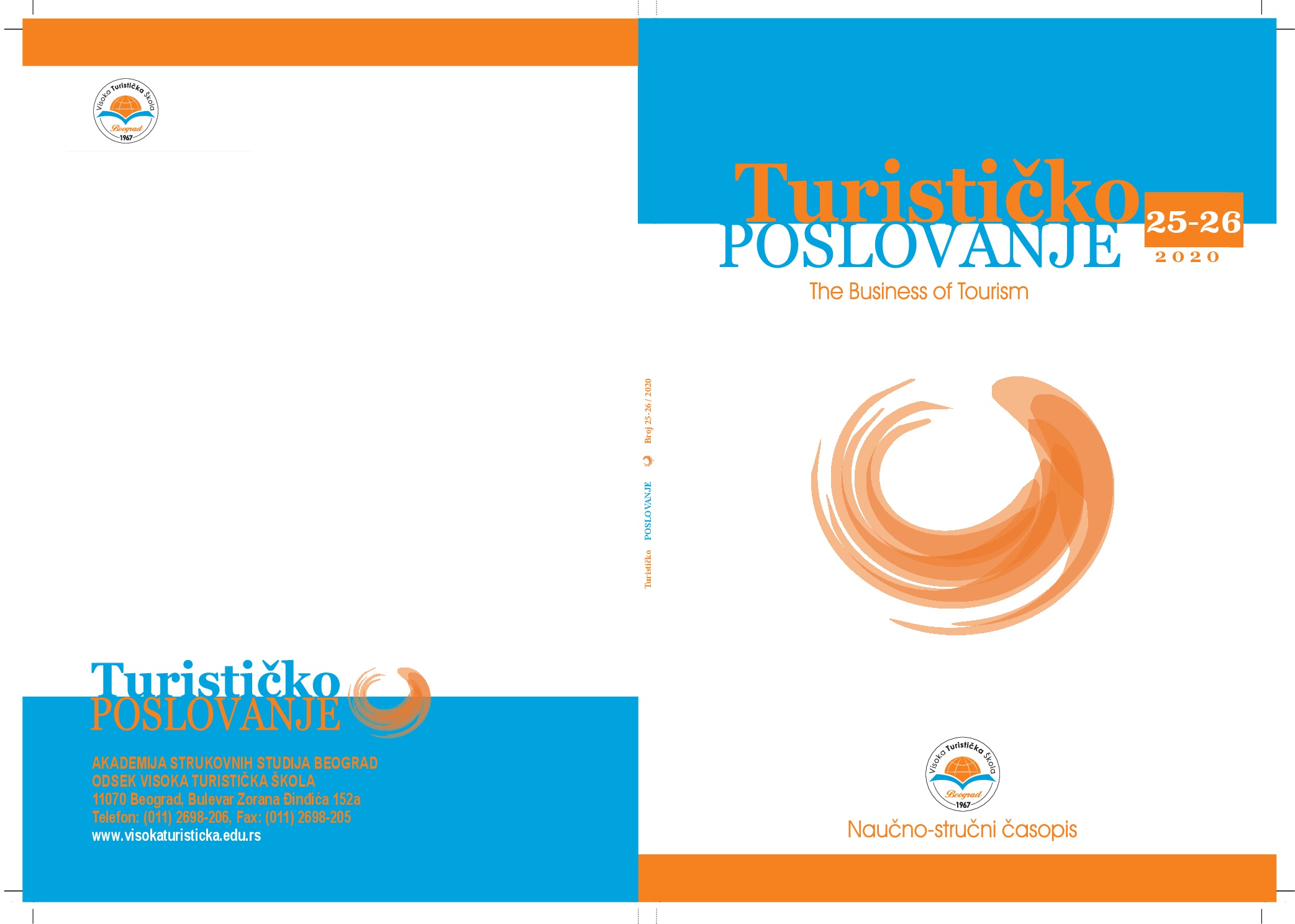SATISFACTION OF GUESTS AT THE GASTROENOLOGICAL OFFER IN BELGRADE
Abstract
Tourism is one of the areas that has begun to develop in the last few year and one of the main reasons for that represent the intensive development of gastronomy. The development of gastronomy and a quality offer of food and drinks is one of the means for ensuring the quality of the guest in a restaurant. Special attention in the gastronomic area is represented by the gastroenolic offer, ie the offer of food and wine, which requires special care of the food on the plate and the wine that is served with it. This paper will present the results obtained after conducting research in several Belgrade restaurants in order to examine the satisfaction of users with their gastroenological offer. Over the past years, the literature has been enriched by numerous studies which talk about the factors that affect on the level of satisfaction with gastroenological offers and the list of the most important factors includes gender, age, education, occupation, family status. After detailed analysis of the obtained results, it has been concluded that the guests of Belgrade restaurants are satisfied with the gastrooenological offer, but a small percentage of respondents, who are not satisfied with this offer, increase the need for improve catering services and also gastroenological offer.
References
2. Bakan, R., Salopek, D. (2015) Moderni trendovi u prehrani i njihov utjecaj na ugostiteljsku kuhinju. Praktični menadžment, vol. VI, br. 1, str. 105-110.
3. Beckett, F. Lingwood, W. (2005) Cooking with wine. English: Ryland Peters & Small.
4. Cohen, E., Avieli, N. (2004) Food in tourism: Attraction and impediment. Annals of tourism research, 31(4). Pp. 755-778.
5. Dodd, T., Bigotte, V. (1997). Peceptual Differences Among Visitors Groups to wineries. Journal of Travel Research, 35(3), pp. 46-51.
6. Gagić, S., Tešanović, D., Kalenjuk, B. (2014) Unapređenje restoraterskog poslovanja primenom inovacionih strategija. Turističko poslovanje, br. 14, str. 91-99.
7. Gonzalez, A., Curtis, C., Washburn, I., Shirsat, A. (2019) Factors in tourists food decision processes: a US-based case study. Journal of Tourism Analysis, vol. 27, no. 1, pp. 2-19.
8. Hjalager, A.M., Richards, G. (2002) Tourism and Gastronomy. London: Routledge.
9. Ignatov, E., Smith, S. (2006) Segmenting Canadian culinary tourists. Current Issues in Tourism, 9 (3), p. 235.
10. Kalenjuk, B. (2013) Vojvodina kao destinacija gastronomskog turizma. Doktorska disertacija. Prirodno-matematički fakultet Univerziteta u Novom Sadu.
11. Kalenjuk, B., Tešanović, D., Škrinjar, M., Đeri, L. (2012) The importance of authentic food in the development of the culinary tourism in Vojvodina. In: 1st Belgrade International Tourism Conference 2012: Contemporary Tourism - Wishes and Opportunities, March 22-24, 2012. Belgrade: College of tourism, pp. 293-300.
12. Khan, M. A., Hackler, L. R. (1981) Evaluation of food selection patterns and preferences. Critical Reviews In Food Science & Nutrition, 15 (2), pp. 129-153.
13. Meler, M., Cerović, Z. (2003) Food marketing in the function of tourist product development. British Food Journal, 105(3), pp. 175-92.
14. Mills, S., Adams, J., Wrieden, W., White, M., Brown, H. (2018) Sociodemographic characteristics and frequency of consuming home cooked meals and meals from out of home sources: cross-sectional analysis of a population-based cohort study. Public Health Nutrition, 21(12), pp. 2255-2266.
15. Nield, K., Kozak, M., LeGrys, G. (2000) The role of food service in tourist satisfaction. International Journal of Hospitality Management, 19(4), pp. 375-384.
16. Ninković, D. (2007). Slaganje hrane i vina. Beograd: Special Press.
17. Pivac, T. (2012) Vinski turizam Vojvodine. Mongografija. Prirodno-matematički fakultet Univerziteta u Novom Sadu.
18. Quan, S., Wang, N. (2004) Towards a structural model of the tourist experience: an illustration from food experiences in tourism. Tourism Management, 25(3), pp. 297-305.
19. Rabotić, B. (2013) Gastronomija kao turistička atrakacija. Hotelska kuća – međunarodni zbornik naučnih i strunih radova (31.10-1.1.2013. Zlatibor), str. 473-483. Dostupno na: https://www.academia.edu/8047844/Gastronomija_kao_turisti%C4%8Dka_atrakcija [08.04.2020.].
20. Savić, S., Čekrlija, S., Mitrović, V. (2019) Vino i hrana. Podgorica: Zavod za uxbenike i nastavna sredstva.
21. Tassiopoulos, D. Nuntsu, N., Haydam, N. (2004) Wine tourists in South Africa: A demographic and psychographic study. Journal of Wine Research, 15 (1), pp. 51-63.
22. Tešanović, D. (2011) Gastronomska obrada mesa. Beograd: Visoka hotelijerska škola strukovnih studija.
23. Tešanović, D. (2016) Osnove gastronomije za menadžere. Novi Sad: Prirodno-matematički fakultet Univerziteta u Novom Sadu.
24. Vukić, M., Portić, M. (2007) Gastronomska ponuda u ruralnom turizmu. Novi Sad: Prirodno-matematički fakultet Univerziteta u Novom Sadu.

